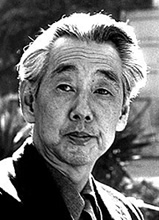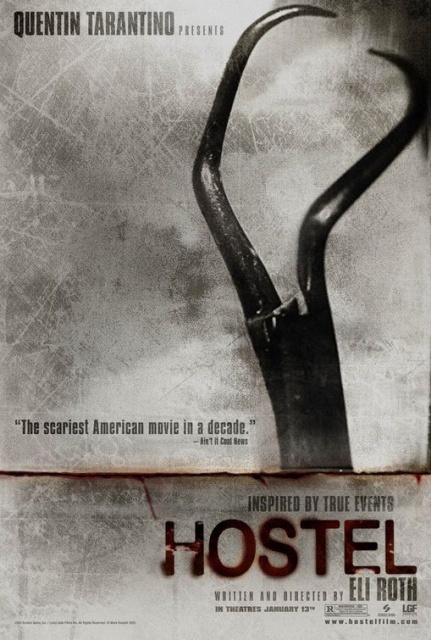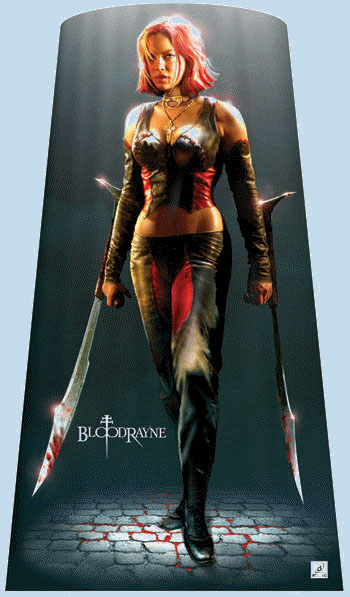Chicago Indymedia : http://chicago.indymedia.org/archive
LOCAL Review :: Media
Another set of radical film reviews from CIMC
Films reviewed: Three Sisters with Maiden Hearts, Memoirs of a Geisha, Hostel, Wolf Creek, BloodRayne
Three Sisters with Maiden Hearts is screening on Saturday, Jan. 21 at the Siskel (5:30pm). Wolf Creek is showing at the AMC Ford City. The other films are playing at locations throughout the city.
Three Sisters with Maiden Hearts is screening on Saturday, Jan. 21 at the Siskel (5:30pm). Wolf Creek is showing at the AMC Ford City. The other films are playing at locations throughout the city.

Three Sisters with Maiden Hearts
“Don’t get smart. You’re not a princess.”
Was Mikio Naruse seventy years ahead of his time or is Rob Marshall seventy years behind? Comparing Three Sisters with Maiden Hearts with Memoirs of a Geisha is startling for Naruse’s portrayal of strong female characters struggling in a system that does its best to keep them subservient. A strong feminist message would be nice to see in more films today. Instead we’ve got crap like Monster-in-Law where the formerly formidable Fonda, Jane that is, ends up “trafficking in regressive, reactionary, blatantly sexist gender codes”. MOAG is more along the lines of the latter and pales likes a geisha’s makeup in comparison to Naruse’s wonderful film.
Opening with a series of great shots of life in Tokyo’s Asakusa ghetto, the film centers a group of “sisters” living in a geisha house run by “mother” Hahaoya (Chitose Hayashi). Oshima (Masako Sanjo) and Osome (Masako Tsutsumi) hit bars singing and playing shamisen music for tips. Cheiko (Ryuko Omezono) has taken a different path dancing in an American-style cabaret joint. Mother doesn’t approve of Cheiko’s job and thinks even less of her burgeoning romance with Aoyama (Heihacharo Okawa). The break from pattern threatens the house’s earnings and when the poor stray from the path, no matter how innocuously, the results can be dire, a warning not heeded by Cheiko. Mother’s dictatorial control already led to Oren (Chikako Hosokawa) bolting at the first possible opportunity and Cheiko appears to be next. Oren’s history with organized crime comes into play as she and her infirm husband try to exchange urban for rural poverty. Osome does what she can to help each of her sisters while trying to appease Mother. Giving some of her earnings to Oshima is tough but her sacrifices increase plenty as they all struggle just to try to retain an unenviable status quo.
TSWMH was Naruse’s first sound film and his most visually experimental. For long periods he keeps the camera in motion along with the sisters as they navigate their way through Asakusa’s seedier parts. When the camera does stop Naruse goes to great lengths to frame each scene memorably. A simple, brief, beautiful shot of a paddle pushing a rowboat across the screen is made all the more effective for the static camera after the long periods of action. The sophisticated use of voice-over and sound effects put the technical proficiency of the film far above most 1935 fare.
Mikio Naruse is somewhat a nonentity in the United States. Despite support from several prominent critics like Susan Sontag & Audie Bock his films are generally unavailable. As of this publishing there is not a single Naruse film available on DVD in the United States and Amazon.com only lists two (of eighty-nine) on VHS. His sober shomin-geki films should have made him a giant along the lines of Ozu and Kurosawa long ago. The current tour of Naruse films will be at the Gene Siskel Film Center through the end of February and should not be missed by anyone with an interest in cinema. Three Sisters with Maiden Hearts is a great, great film. Naruse did make better films later on with narratives that were more tightly woven. That said, this film is one of his most visually stunning and his later, greater films aren’t that much bette as there’s only so much room for improvement.

Memoirs of a Geisha
The emperor has no kimono, Memoirs of a Geisha disrobed
One goal when writing a review should always be length. A review should be sufficient to describe and praise/criticize but not so long that the reader loses interest. Getting the praise out should be easy enough in this case but it would take several tomes to collect and describe all that is wrong with this ridiculous film. Rob Marshall’s Memoirs of a Geisha is a boring, long-winded, offensive exercise in exotification that is as wrong-headed as it is bizarre.
The stupidity starts with the casting. Though none are completely awful the casting of many roles is mind-boggling. It’s strange enough that conspicuously non-Japanese are playing Japanese characters but MOAG isn’t the first film to do this. For example in Peter Lorre played Kentaro Moto eight times, one of three Japanese roles the Austrian would play. Of course this was done between 1937-1939 when actual Japanese people in Hollywood were relatively few. Speaking of the 1930’s, Mikio Naruse’s Three Sisters with Maiden Hearts (1935) has a much more authentic portrayal of the lives of geishas and the struggle for some control over one’s life for Japanese women during a period of intense discrimination. One would hope MOAG could be at least self-consistent in casting. Instead Chiyo (Suzuka Ohgo) grows up to be, not only a geisha, but a Chinese one. Barring drastic plastic surgery, most folks this reviewer knows tend to stay one ethnicity for their entire lives. That is a far greater flaw than a pan-Asian cast. That cast presents other problems. Perhaps it’s Marshall trying for some historical poetic justice when he has Koreans and Chinese butcher Japanese words like the Japanese were butchering Chinese and Korean people during the time period most of this film takes place in. One would expect non-Japanese performers to have something less than perfect accents when using Japanese words or [shudder] speaking Japanese and it can hardly be held against the performers but it’s distracting from the story...
...and boy is it a story that needs distracting from. What starts out appearing to be a tragedy of class and gender exploitation turns into a bizarre glorification of sex slavery. The recent TV miniseries Human Trafficking portrayed some comparable situations in a much less favorable light. HT however, dealt with white folks from the Balkans, not mysterious, exotic Asian people who of course don’t suffer the same. According to the film, in a classy joint like the one Sayuri (Ziyi Zhang) works in, one will only have sex for money once (until you get a danna anyway), when one’s virginity is auctioned off. The audience is supposed to sit in some kind of awe when it’s announced that Sayuri’s “cave” fetches ¥15,000 a new record of some sort [An amount, by today’s exchange rates, this reviewer has spent on Long Island Iced Teas to a sloppily similar effect. There, that should take any remaining magic out of it.]. The talk of “caves” and “eels” is hardly atypical of the dialogue provided by the ferociously untalented Robin Swicord (Practical Magic). With less frat and more brat come the lines from Hatsumomo (Li Gong), a geisha who does little more than pout and throw tantrums while torturing Sayuri. Her unipolar nature might be softened by the tragedy of her own life. She is, after all, more or less a sex slave. In MOAG though, she is a spoiled child who wastes no opportunity to hurt others. At least she gets some slight redemption by uttering the only good line in the film, “My pumpkin always tells the truth.”
There is a lot more wrong with this shit blizzard than what’s written above. But let us not dwell totally on the negative for the film has a plural of positive qualities. It is gorgeously shot and the costumes are very pretty. Also, Ziyi Zhang and Koji Yakusho put in excellent performances in their contrived, simplistic roles. See? A plural. It’s not nearly enough to make the film watchable, not at almost 2.5 hours. If the film didn’t take itself so seriously there could be a campy effect to the harebrained melodrama. Instead one leaves the theater as if surfacing from a sewer. It’s as Sayuri said, “A story like mine should never be told.”

Hostel
Hostility for Hostel.
Eli Roth’s Hostel opens up great. Three chumps, two Americans and an Icelander, are in Amsterdam doing the things that dumb Americans generally do in that city of liberalized drug laws. They are stereotypically doltish and a joke or two is seemingly had at their expense. Then the reality sets in. Those weren’t jokes. This isn’t a satire. The script really is that stupid. It could be that the utter nonsense that is the dialogue is meant to keep the characters as unlikable as possible so their eventual demise is less a problem for the audience. If that’s the case it works like a charm. All the characters are eminently punchable. What then, is the point of the film though? Any audience members not sporting greek symbols on their hoodies won’t feel too moved by a few jackass horndogs getting mutilated. Sure it would still be gross but the lack of connection to the character takes most of the terror out of something bad happening to them.
Paxton (Jay Hernandez), Josh (Derek Richardson) and Oli (Eythor Gudjonsson) are teaming up against the evil forces of common sense and tact in their efforts to get high and laid. This is not unlike the qualitatively similar film EuroTrip. The three make asses of themselves in Amsterdam where they meet Herpes Lipsore who lets them know where there is some real action, Slovakia! To Bratislava the group goes where they check into a hostel but not after meeting a creepy Dutch dude who “likes to work with [his] hands.” Natalya (Barbara Nedeljakova) and Svetlana (Jana Kaderabkova) greet them in partial nudity before inviting them to get dirty in a spa. Soon enough the group is thoroughly drunk and naked doing the things drunk & naked people tend to do. This might sound like at least a bit of campy fun but it’s not. The terrible acting from the two male leads and the aggressively asinine script take pretty much all the fun out of it. Oli is the only character giving any energy to the film and uh, the film loses his energy all too quickly. This is a huge problem when a certain level of frenetic activity is needed to keep the pace between scenes of gore.
Hostel has a sheen of professionalism to it that helps cover up a few of the minor flaws and certainly makes the gore scenes realistic. The lack of quality in every other area though makes the film impossible to recommend. It’s a stupid film that has exactly zero story. It seems to exist solely as a series of scenes of simulated gore and sex. That’s pretty much exploitation by definition. A little quality dialogue or a couple of compelling performances could have helped make the film into a cult classic but no cult this side of Jonestown is gonna find much to like.

BloodRayne
“Beyond the things normal people can do.”
He is the world’s worst working director. His works are absolutely terrifying without being suspenseful or scary at all. He is Germany’s worst export since National Socialism. He is, Uwe Boll, and he has released another movie. BloodRayne is Boll’s third consecutive film based on a video game. About this time last year he released the turdfest Alone in the Dark and was roundly condemned by human rights organizations for casting Christian Slater and Tara Reid in the same movie. Set in Romania sometime during the 1700’s BloodRayne tells, no wait, inflicts upon us a story of Rayne, an immensely powerful dhampir (half-human, half-vampire) and her quest for something revenge-like, though the offense for which she is avenging changes a couple of times.
The film opens with Vladimir (a mulleted Michael Madsen) seeking information on where to find undead creatures to kill from some bartender. He is joined by Sebastian (Matt Davis) and Katarin (Michelle Rodriguez), one of the numerous Caribbean latinas living in Romania at the time. They are part of some Brimstone society thingy that apparently exists solely to hunt vampires. The bartender drops the trio a tip about Rayne (Kristinna Loken), a dhampir held in captivity by a traveling freak show that includes an obese bearded woman who walks through one scene for no apparent reason. It is somewhat puzzling as to how Rayne manages to beat down so many vampires throughout the film when she is easily, and continually, subdued by one or two carnies. Her part in the carnival show is to demonstrate her power of healing after she is burned by having water put on her skin. Considering that her skin and the air around her contain a lot of water it must be a terrible problem. But then again the water doesn’t seem to hurt her unless it’s poured on her by other people since rain and dew don’t seem to have the same effect. Anyhoo Rayne eventually busts out of her flimsy wooden cage and starts a revenge quest against Kagan (Ben Kingsley in a funny wig). By the time the film get to this point, maybe ten minutes in or so, the audience is already dizzy from a camera that never stops moving and doesn’t always stay in focus. The real horror from this vampire flick comes at this point as you realize that it’s going to last another 84 minutes. It’s the kind of dreadful terror that will evacuate your bowels.
Rayne, hiding amongst the Romanian peasantry in tight leather pants and a v-neck halter top, runs into Vladimir’s crew and they decide to combine their efforts against Kagan. Their first venture leads them to Meatloaf’s lair where they find him immersed in paradise by the candle light. He dies. However Rodriguez is in allegiance with her father Elrich (Billy Zane, also in a funny wig) and sells out much of Brimstone for her family’s plans. Whoops. That was a spoiler I guess. Anyway everyone but Rayne dies by the end which, thinking about it, is kind of another spoiler. The spoilers aren’t really a big deal though because judging by the opening weekend box office, nobody is going to see this film.
Boll has constructed this Scheißfilm so that there is no logical connection between the information the characters have and their actions. They just kind of assume, based upon nothing, the next thing they should do. The dialogue is so stupid that it must have been difficult to recite. The fight scenes often have characters who appear to struggle to wield their swords. The men’s costumes look like they come from bad period love story books. Kagan is some type of evil king but his effectiveness must be questioned as he does nothing but sit in a darkened room by himself. After several box office failures and uniform critical damnation it’s very puzzling to wonder about how “Toilet” Boll continues to raise money for his ghastly deeds. That’s not the big question though. At the screening I attended, several people left early. The big question is, what was wrong with the rest of us?

Wolf Creek
“That’s not a knife. This is a knife!”
“It feels like we’ve been driving for hours...Do you think it means anything?...Oh there’s poo everywhere, yay!...I’ve got the worst taste in my mouth.”
Zingers, all of them! Ooh those lines from Wolf Creek could be used to for petty jabs at the film, taking the scripts own words and throwing it back at ‘em. Few recent films have provided a similar quantity of ammo for such endeavors. If only Wolf Creek was a bad film. If only, each of those lines and others would at this moment be cheekily ripping the film in the same manner the evil dude rips the people in the movie. But Wolf Creek is not a bad film. It won’t win many awards but a competent, original-ish, well acted, clever, down-to-earth horror film is something to be savored in these days of by-the-numbers fright flics.
Liz (Cassandra Magrath) and Kristy (Kestie Morassi) are nice British girls visiting Australia. They’ve stumbled into a summer with Ben (Nathan Phillips), a young Australian fellow. They’re partying hard and getting ready for a road trip through inland Australia. They buy a dirt cheap car and get moving, and keep moving in an unfortunately long driving montage, through several different ‘Hall’s, Emu and other Creeks until arriving at the titular town. The set up is nicely done with enough wit and direction to establish the characters and build up a little suspense. There’s even a curve ball or two tossed in to help keep the audience on its toes. At Wolf Creek they have, yep, car trouble. Luckily a nice fellow named Mick (John Jarratt) with a mechanic’s truck is around to give them a tow. Of course a burly dude driving a huge truck through a rural area to pick up stranded travelers late at night would never arouse any suspicion in a few backpacking teenagers. Oops, their bad.
The first part of the film with the parties, beaches and highways is brightly shot on hand-held HD cameras lending a light, breezy quality to the scenes. As the subject matter gets darker so does with film with scenes of terror frames by shadows. As with any film this gory the effects are important and the various scenes of nastiness are done with remarkable skill. While squirming in the seat ones thinks, “Yes, yes that’s probably what that would really look like.” A big surprise for a film with a relatively tiny budget is the effective soundtrack. François Tétaz put together excellent mood music to help guide the film along.
As various characters begin to meet their various fates Wolf Creek makes a few missteps, falling into a few horror clichés. ‘Cause really, does there have to be someone in the back seat? Can’t a car just start on the first try? It’s not enough to bring down the entire film but they are minor disappointments. The story is has more gore than Tennessee and folks who get squeamish might consider passing on it. It is a worthwhile trip though and much more than a simple exploitation flic. Commenting on both the frontier mentality and the brutalization of Australian participants in American wars Wolf Creek offers quite a bit of thought provoking material, and severed limbs.
Comments and discussion are welcome. Pax, JJ
Information Library
Views
Search
Account Login
Media Centers
- worcester
- western mass
- vermont
- urbana-champaign
- tennessee
- tampa bay
- seattle
- sarasota
- santa cruz, ca
- santa barbara
- san francisco bay area
- san francisco
- san diego
- saint louis
- rogue valley
- rochester
- richmond
- portland
- pittsburgh
- philadelphia
- oklahoma
- nyc
- north texas
- north carolina
- new orleans
- new mexico
- new hampshire
- minneapolis/st. paul
- milwaukee
- michigan
- miami
- maine
- madison
- la
- kansas city
- hudson mohawk
- houston
- hawaii
- dc
- columbus
- colorado
- cleveland
- chicago
- charlottesville
- buffalo
- boston
- binghamton
- big muddy
- baltimore
- austin indymedia
- austin
- atlanta
- asheville
- arkansas
- arizona
- valencia
- united kingdom
- ukraine
- toulouse
- toscana
- torun
- switzerland
- sverige
- scotland
- sardegna
- russia
- romania
- roma
- portugal
- poland
- piemonte
- patras
- paris/Île-de-france
- oost-vlaanderen
- nottingham
- norway
- northern england
- nice
- netherlands
- napoli
- nantes
- marseille
- malta
- madrid
- london
- lombardia
- linksunten
- lille
- liguria
- liege
- la plana
- italy
- istanbul
- ireland
- hungary
- grenoble
- germany
- galiza
- euskal herria
- estrecho / madiaq
- emilia-romagna
- cyprus
- croatia
- calabria
- bulgaria
- brussels
- bristol
- belgrade
- belgium
- belarus
- barcelona
- austria
- athens
- armenia
- antwerpen
- andorra
- alacant
- abruzzo
This site made manifest by dadaIMC software



